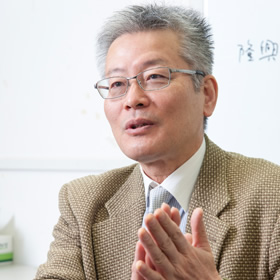 |
| |
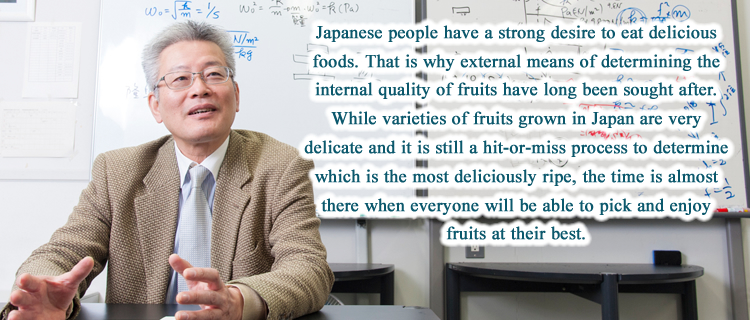 |
| |
|
“You are wasting taxpayers’ money!” His mother’s harsh words
motivated him to extensively explore ways to determine the maturity of fruits without
cutting them.
|
| |
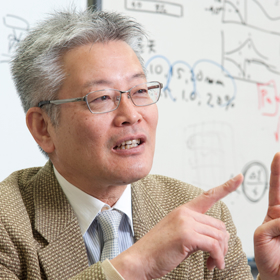 |
|
Professor Sakurai specializes in plant physiology, a discipline
that studies the growth and development of plants. His most noted
research concerns the “development of nondestructive methods of
measuring fruit quality.”
Several methods of checking the ripeness of fruits have
been introduced so far. Initially, these methods assessed only sugar
content through image analysis or near-infrared spectroscopy. These
conventional means, however, were limited in that they were not
applicable to varieties that do not let light through and that they
were incapable of sorting out overripe fruits. Meanwhile, it has
been known since olden times that firmness is one of the reliable
criteria for determining whether a fruit is ripe for the picking. In
fact, it has long been a routine practice for fruit farmers to put a
stick into the flesh of fruits to check their ripeness. Besides,
according to Professor Sakurai, Japan is the most meticulous of all
fruit producing countries in terms of fruit quality assessment
“That is a reflection of Japanese consumers’ enthusiasm
about eating delicious foods,” says the professor. And that is why
there has been a need in this country for even more effective means
of fruit quality assessment.
|
About 20 years ago, Professor Sakurai went to the U.S. to
conduct research on tomatoes and learn various relevant techniques for a
period of one year. His destination was UC Davis in California. The
university conducted numerous studies on tomatoes because the UC Davis
campus was located in the middle of a major tomato producing area that
represented a quarter of the volume of tomatoes processed worldwide.
While in the U.S., Professor Sakurai was asked to
physically assess the maturity of tomatoes. So he cut tomatoes, stuck a
needle into their flesh, measured the resistance that was generated, and
organized numerical data obtained to produce a scientific paper. On his
return home, he exultantly told his mother about his accomplishment in
the U.S. However, his mother sniffed at his story, saying, “I’ve already
known about your ‘findings’ because I cut tomatoes every day. It is a
sheer waste of taxpayer’s money to put into those difficult figures what
you can clearly see just by cutting tomatoes!”
Determined to impress his mother next time around,
Professor Sakurai embarked on a new research project.
|
|
|
|
|
An encounter that resulted in the development of a “nondestructive”
technique for assessing the ripeness of fruits from their firmness
|
| |
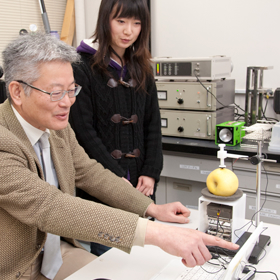 |
|
Guided by the intuition that the “sound” may be the key
parameter, Professor Sakurai started an experiment in which the
sound of various frequencies was applied to fruits so the fruits
could “hear” it and the sound waves that passed through the fruits
were received with a microphone.
Based on his findings, Professor Sakurai wrote several
papers, but he was somewhat uncomfortable about continuing that
research project. At the time he almost decided to end the project,
he was spoken to by a person from a certain company during an
academic society’s poster session.
When that person asked “What are you interested in
doing?”, Professor Sakurai explained about his research interest.
The person responded, “Maybe we can help you. I will send you
documents after I get back to my company.”
After a few days, Professor Sakurai received a bundle
of documents several centimeters thick. Some documents suggested
that it might be the vibration rather than the sound that is the
key. A brochure concerning vibration measuring devices was also
attached. This was the professor’s first encounter with the laser
Doppler vibrometer.
|
When given a vibration, any object resonates with a unique
resonance frequency. Using this rule, one can determine firmness and
maturity of fruit. Because the formula necessary for the procedure had
already been developed by a physicist many years ago, all one had to do was
apply the obtained data to the formula. Convinced of its potential,
Professor Sakurai embarked on studies of this technique somewhere around
1994. For nearly 20 years since then, he has been engaged in research on
this method.
“This vibration technique is a good means of collecting
internal information from living things,” says the plant physiologist.
Although vibration technology itself is advancing day by day, its
application to fruit is unprecedented and Professor Sakurai is the world’s
first scholar to refine fruit quality assessment procedures using vibration
technique to this extent.
In 2005, based on his research results, Professor Sakurai
founded Applied Vibro-Acoustics Inc. (AVA) in Hiroshima University’s Venture
Business Laboratory. In the ensuing year, in cooperation with a professor
who is also his senior researcher, the plant physiologist established
Yamamoto Kagaku Kogyo Inc., a company engaged in the development of a small
device that has the same level of precision as the laser Doppler vibrometer.
|
|
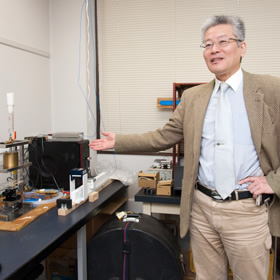 |
|
| |
|
Aspiration to see the laser Doppler vibration promote Japanese agriculture
and lead to the establishment of “Japan Brand”
|
| |
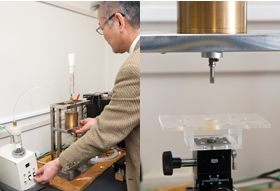
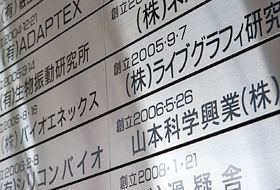 |
|
Asked about the joy of his research, Professor Sakurai says, “The
most exciting part of it is to hear from someone about specific ways
in which the techniques I developed are helping him or her. It is
indeed a pleasant surprise to find that these techniques are being
used for various unpredictable purposes. I really enjoy working in
my lab every day, measuring many different things.”
Furthermore, the professor continues, “One of these
days, we will have kiwifruits, avocados, and a number of other
fruits on supermarket shelves with ‘Best Period to Eat’ labels,
showing shoppers specific dates on which these fruits become most
delicious. Also, fruits such as watermelons sorted and bred using my
vibration technique may be distributed in the market someday, though
such application is invisible. In the years to come, I would like to
work on the La France pear and other fruits whose smells and colors
do not help at all in determining their maturity.” Given the
professor’s strong commitment to his research, we may have a chance
to see the “fruits” of his endeavors with our own eyes in the
not-too-distant future.
Professor Sakurai’s methods will also help establish
“Japan Brand” and promote agricultural exports. “If we can determine
when a fruit will be at its best, we will be able to reduce losses
and increase consumption, thereby rewarding producers for their
efforts. It is my hope to build that kind of mechanism and
contribute to ‘aggressive farming.’”
|
|
| |
| Naoki Sakurai |
Professor
Evaluation of Plant Environment Laboratory
Hiroshima University School of Applied Biological Science
August 1, 1980 – September 30, 1988: Research Associate, School of Integrated Arts and
Sciences, Hiroshima University
October 1, 1988 – March 31, 1993: Associate Professor, School of Integrated Arts and
Sciences, Hiroshima University
April 1, 1993 – March 31, 2006: Professor, School of Integrated Arts and Sciences,
Hiroshima University
April 1, 2006 – Present: Professor, Hiroshima University Graduate School of Biosphere
Science
Retired on March, 2016
|
| |




